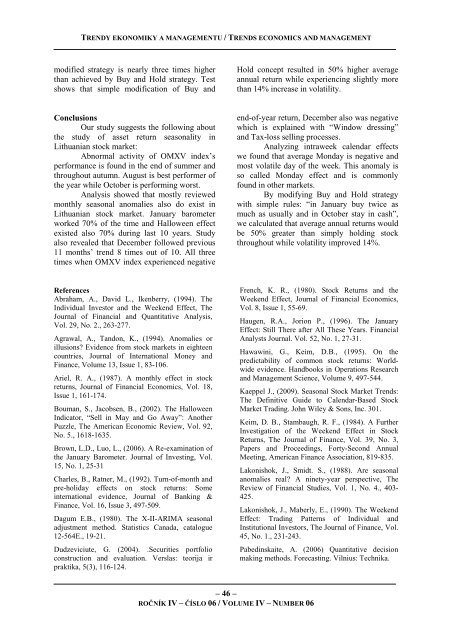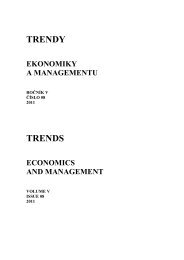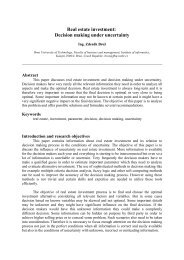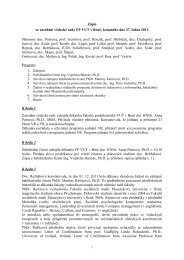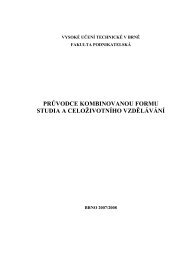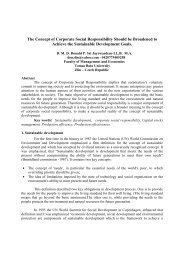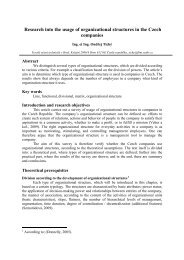Stáhnout toto číslo ve formátu PDF - Fakulta podnikatelská - Vysoké ...
Stáhnout toto číslo ve formátu PDF - Fakulta podnikatelská - Vysoké ...
Stáhnout toto číslo ve formátu PDF - Fakulta podnikatelská - Vysoké ...
Create successful ePaper yourself
Turn your PDF publications into a flip-book with our unique Google optimized e-Paper software.
TRENDY EKONOMIKY A MANAGEMENTU / TRENDS ECONOMICS AND MANAGEMENT<br />
modified strategy is nearly three times higher<br />
than achie<strong>ve</strong>d by Buy and Hold strategy. Test<br />
shows that simple modification of Buy and<br />
Conclusions<br />
Our study suggests the following about<br />
the study of asset return seasonality in<br />
Lithuanian stock market:<br />
Abnormal activity of OMXV index’s<br />
performance is found in the end of summer and<br />
throughout autumn. August is best performer of<br />
the year while October is performing worst.<br />
Analysis showed that mostly reviewed<br />
monthly seasonal anomalies also do exist in<br />
Lithuanian stock market. January barometer<br />
worked 70% of the time and Halloween effect<br />
existed also 70% during last 10 years. Study<br />
also re<strong>ve</strong>aled that December followed previous<br />
11 months’ trend 8 times out of 10. All three<br />
times when OMXV index experienced negati<strong>ve</strong><br />
References<br />
Abraham, A., David L., Ikenberry, (1994). The<br />
Individual In<strong>ve</strong>stor and the Weekend Effect, The<br />
Journal of Financial and Quantitati<strong>ve</strong> Analysis,<br />
Vol. 29, No. 2., 263-277.<br />
Agrawal, A., Tandon, K., (1994). Anomalies or<br />
illusions? Evidence from stock markets in eighteen<br />
countries, Journal of International Money and<br />
Finance, Volume 13, Issue 1, 83-106.<br />
Ariel, R. A., (1987). A monthly effect in stock<br />
returns, Journal of Financial Economics, Vol. 18,<br />
Issue 1, 161-174.<br />
Bouman, S., Jacobsen, B., (2002). The Halloween<br />
Indicator, “Sell in May and Go Away”: Another<br />
Puzzle, The American Economic Review, Vol. 92,<br />
No. 5., 1618-1635.<br />
Brown, L.D., Luo, L., (2006). A Re-examination of<br />
the January Barometer. Journal of In<strong>ve</strong>sting, Vol.<br />
15, No. 1, 25-31<br />
Charles, B., Ratner, M., (1992). Turn-of-month and<br />
pre-holiday effects on stock returns: Some<br />
international evidence, Journal of Banking &<br />
Finance, Vol. 16, Issue 3, 497-509.<br />
Dagum E.B., (1980). The X-II-ARIMA seasonal<br />
adjustment method. Statistics Canada, catalogue<br />
12-564E., 19-21.<br />
Dudzeviciute, G. (2004). .Securities portfolio<br />
construction and evaluation. Verslas: teorija ir<br />
praktika, 5(3), 116-124.<br />
– 46 –<br />
ROČNÍK IV – ČÍSLO 06 / VOLUME IV – NUMBER 06<br />
Hold concept resulted in 50% higher a<strong>ve</strong>rage<br />
annual return while experiencing slightly more<br />
than 14% increase in volatility.<br />
end-of-year return, December also was negati<strong>ve</strong><br />
which is explained with “Window dressing”<br />
and Tax-loss selling processes.<br />
Analyzing intraweek calendar effects<br />
we found that a<strong>ve</strong>rage Monday is negati<strong>ve</strong> and<br />
most volatile day of the week. This anomaly is<br />
so called Monday effect and is commonly<br />
found in other markets.<br />
By modifying Buy and Hold strategy<br />
with simple rules: “in January buy twice as<br />
much as usually and in October stay in cash”,<br />
we calculated that a<strong>ve</strong>rage annual returns would<br />
be 50% greater than simply holding stock<br />
throughout while volatility impro<strong>ve</strong>d 14%.<br />
French, K. R., (1980). Stock Returns and the<br />
Weekend Effect, Journal of Financial Economics,<br />
Vol. 8, Issue 1, 55-69.<br />
Haugen, R.A., Jorion P., (1996). The January<br />
Effect: Still There after All These Years. Financial<br />
Analysts Journal. Vol. 52, No. 1, 27-31.<br />
Hawawini, G., Keim, D.B., (1995). On the<br />
predictability of common stock returns: Worldwide<br />
evidence. Handbooks in Operations Research<br />
and Management Science, Volume 9, 497-544.<br />
Kaeppel J., (2009). Seasonal Stock Market Trends:<br />
The Definiti<strong>ve</strong> Guide to Calendar-Based Stock<br />
Market Trading. John Wiley & Sons, Inc. 301.<br />
Keim, D. B., Stambaugh, R. F., (1984). A Further<br />
In<strong>ve</strong>stigation of the Weekend Effect in Stock<br />
Returns, The Journal of Finance, Vol. 39, No. 3,<br />
Papers and Proceedings, Forty-Second Annual<br />
Meeting, American Finance Association, 819-835.<br />
Lakonishok, J., Smidt. S., (1988). Are seasonal<br />
anomalies real? A ninety-year perspecti<strong>ve</strong>, The<br />
Review of Financial Studies, Vol. 1, No. 4., 403-<br />
425.<br />
Lakonishok, J., Maberly, E., (1990). The Weekend<br />
Effect: Trading Patterns of Individual and<br />
Institutional In<strong>ve</strong>stors, The Journal of Finance, Vol.<br />
45, No. 1., 231-243.<br />
Pabedinskaite, A. (2006) Quantitati<strong>ve</strong> decision<br />
making methods. Forecasting. Vilnius: Technika.


